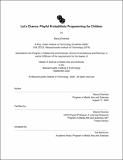Let's chance : playful probabilistic programming for children
Author(s)
Dhariwal, Manuj.
Download1227785089-MIT.pdf (5.038Mb)
Alternative title
Playful probabilistic programming for children
Other Contributors
Program in Media Arts and Sciences (Massachusetts Institute of Technology)
Advisor
Mitchel Resnick.
Terms of use
Metadata
Show full item recordAbstract
Probabilistic thinking has been one of the most powerful ideas in our intellectual heritage, and it's rapidly gaining even more relevance as it lies at the core of artificial intelligence (AI) systems and machine learning (ML) algorithms that are increasingly becoming ubiquitous, but still largely remain as black boxes for most people. This new context gives new power to this historically powerful idea and offers new opportunities for exploring how to make it accessible to all children growing up in this era. This thesis presents Let's Chance--a new type of computational microworld that extends the Scratch Programming Language with new types of custom designed blocks and representations that make it accessible for children to discover and experiment with the rich ideas and sophisticated concepts of probabilistic thinking, modeling, and learning through creative exploration. Using the tool, children can imagine and code a wide variety of expressive, playful, and personally meaningful probabilistic projects, such as--generative art, music, or text; chance-based games and stories; interactive visualizations and simulations; and even advanced projects for making a computer learn from input data using simple Markov models of probabilistic learning, among many others. This work stands in stark contrast with most existing approaches used for probability instruction, which are typically abstract, impersonal, narrowly focused on covering specific concepts, and often reduce probability to mere calculation of fractions--making it unlikely for the underlying big ideas of probability to generalize and blossom in the minds of young learners. We hope that Let's Chance provides a meaningful new pathway for children towards transforming these big ideas into their Big Ideas! We share the motivations and inspirations behind this work, describe the design and functionality of Let's Chance through examples of diverse creative projects, and share observations and feedback from pilot workshops with children. We also highlight starter resources designed for educators and discuss the relevance of this work in the context of growing interest towards AI education for children. Finally, we share some reflections on how to design for making creative possibilities possible for all learners, and what a flourishing microworld might look like.
Description
Thesis: S.M., Massachusetts Institute of Technology, School of Architecture and Planning, Program in Media Arts and Sciences, September, 2020 Cataloged from student-submitted PDF version of thesis. Includes bibliographical references (pages [58]-[59]).
Date issued
2020Department
Program in Media Arts and Sciences (Massachusetts Institute of Technology)Publisher
Massachusetts Institute of Technology
Keywords
Program in Media Arts and Sciences